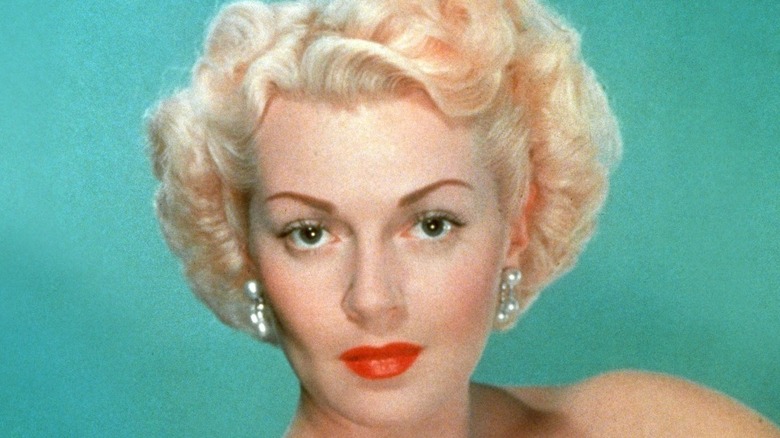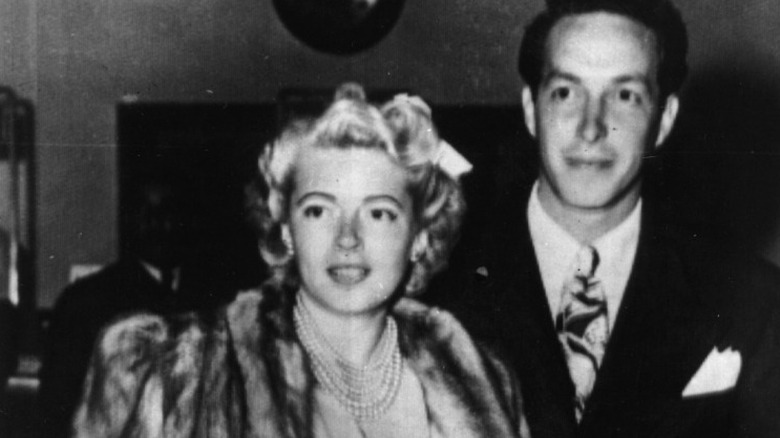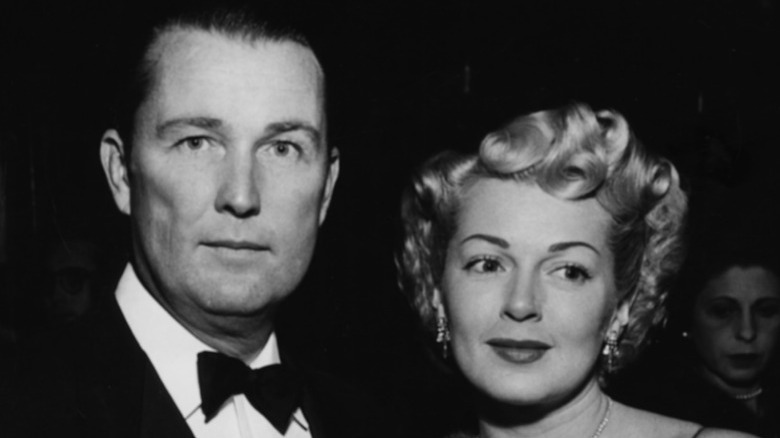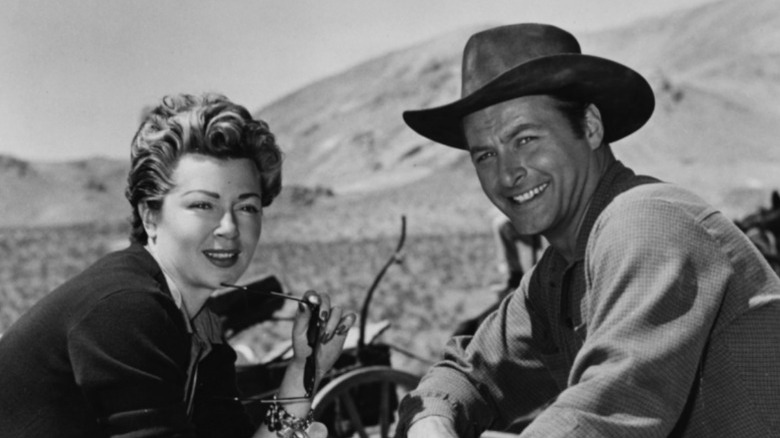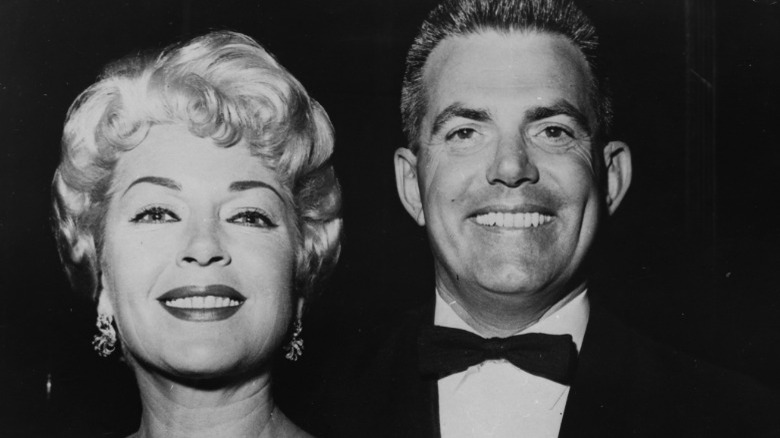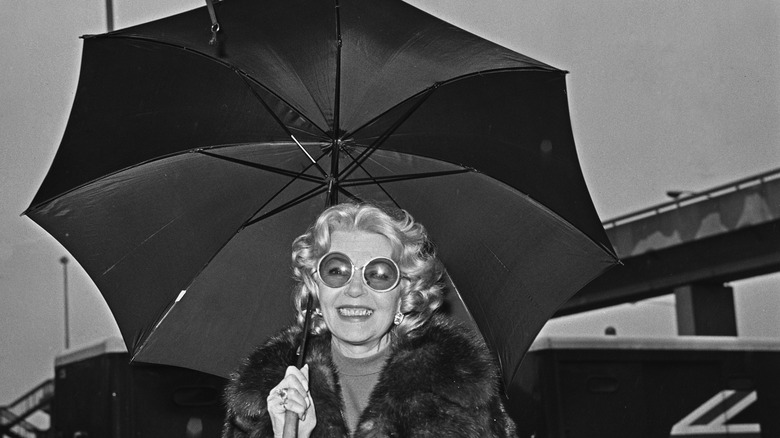The Truth About Lana Turner's Marriages
Actress Lana Turner sizzled on screen, becoming one of the most popular, sultry film sirens of the 1940s and 1950s, per Closer Weekly. Discovered as a teenager, she soon found herself a rising Hollywood talent. The beautiful blonde earned the nickname "Sweater Girl" for the close-fitting top she wore in her first film, "They Won't Forget" (1937), and she soon had legions of admirers. Turner later described her movie debut as "I was just a 15-year-old kid with a bosom and a backside strolling across the screen" (via The Washington Post).
Off-screen, Turner seemed to be remarkably unlucky in love. Her first marriage, to bandleader Artie Shaw, proved to be a brief and disastrous union. Shaw (per The Atlantic) had been engaged to actress Betty Grable when he whisked Turner off to Las Vegas. According to the San Pedro News Pilot, Turner and Shaw tied the knot there on February 13, 1940. The ink on their marriage certificate had barely dried by the time the relationship started to fall apart. Turner, only 19 years old at the time, filed for divorce that July, claiming that Shaw had "wrongfully inflicted upon the defendant grievous mental suffering."
Turner married the same man twice
Turner soon found love again, but lasting happiness seemed to elude her. She married restaurateur Steve Crane in 1942, but she found out that it wasn't official, since Crane's divorce from his first wife wasn't finalized (per Mental Floss). While that first attempt at marriage was annulled, the pair tried again in 1943. Turner was pregnant at the time with her only child, daughter Cheryl, but having a baby together did nothing for their relationship. Turner filed for divorce in 1944.
While her romantic life may have been failing, Turner enjoyed success with such films as "Slightly Dangerous" (1943) and "The Postman Always Rings Twice" (1946) around this time. It wasn't long, though, before Turner was willing to try luck again with love. This time around, she fell for a fellow film star, Tyrone Power, in 1946 (per Closer Weekly). Turner described him as "the most gentlemanly, enchanting man I had ever known," but he, like Crane, was still married when they got together. She became pregnant by Power, but she chose to have an abortion. Having a baby out of wedlock would have sunk both of their careers.
Turner married a millionaire
While her relationship with Power ended in heartbreak, Turner seemed determined to find love. She married tin-plate heir Henry J. "Bob" Topping (above) in April 1948. He had proposed by putting a diamond ring in her Martini glass while the pair were at Los Angeles' 21 Club, per the National Auto Museum. The couple enjoyed living the high life, but Turner's enthusiasm for the union waned as Topping lost money to gambling habit and poor investments. Still, this roughly four-year-long marriage proved to be her longest stretch as a wife to date.
Turner's romantic troubles didn't put a dent in her acting career, however. She divorced Topping in December 1952, shortly before the release of "The Bad and the Beautiful." This film, which offered moviegoers a dramatic glimpse inside Hollywood, became a big hit. Turner played an actress, named Georgia Lorrison, who was involved with a ruthless movie producer, played by Kirk Douglas (per Britannica).
Turner picked the wrong men
Before long, Turner thought she had found Mr. Right in fellow actor Lex Barker (above). The tall, handsome performer was best known for his "Tarzan" movies, and he and Turner wed in 1953. But soon after they married, reportedly, Barker began to sexually abuse Turner's daughter, Cheryl, according to People magazine. Turner didn't know what was happening until later. Her daughter eventually told her grandmother about the alleged abuse, and the grandmother told Turner. Turner reportedly put a gun to Barker's head and debated killing him. She kicked him out of the house and divorced him instead.
That disastrous marriage was followed by Turner's most infamous relationship, and once again her daughter was caught in the middle. Turner got involved with Johnny Stompanato, a mobster with ties to Mickey Cohen's criminal organization, per The Washington Post. During one heated argument in 1958, Stompanato threatened to disfigure and kill Turner. Her daughter, Cheryl Crane, rushed to Turner after hearing her call for help. She ended up stabbing Stompanato with a kitchen knife; he died of his injuries.
Turner remained unlucky in love
In the wake of Stompanato's death, Turner and her daughter were both the target of intense media scrutiny. Cheryl Crane was acquitted of Stompanato's murder because it was determined to be justifiable homicide, according to an Associated Press report. She became a ward of the court after the murder. Despite all of her family issues and personal challenges, Turner managed to turn in one of her most acclaimed performances around this time. She earned an Academy Award nomination (per IMDb) for her work in the suburban drama "Peyton Place" (1957).
Turner continued to look for a lasting relationship, hoping to find "some security and peace" (via Closer Weekly). She thought she might have found it with rancher Fred May. The pair wed in 1960, according to the Desert Sun. Turner's daughter Cheryl was given a pass from a school for troubled girls to attend the event. Turner and May ended up divorcing in 1962, per The Washington Post. Turner tried going for a Hollywood type for her next trip to the altar, marrying producer Robert Eaton in 1965.
Lana Turner decided to go solo
Turner was 44 years old when she married Eaton, who was a decade younger than she. Her film career had started to decline, and his efforts to revive it fueled the demise of their marriage. According to the Palm Beach Post, Eaton worked to develop a TV series for Turner. When he hired Harold Robbins as a writer on the project, Turner became deeply upset. Robbins had written a novel inspired by Johnny Stompanato's death. She lost interest in the TV series and her husband. The pair finalized their divorce in 1969.
Turner tried one more time for marital happiness, tying the knot later that year with Ronald Dante. He was a self-styled hypnotherapist, performing under the name Dr. Dante, per the Chicago Tribune. (He's the subject of a short documentary, "Mr. Hypnotism," posted on YouTube.) This union proved to be Turner's last marriage. When the couple divorced in 1972, she was done with love. "I am not ashamed to say that I have no desire to marry again," Turner once said (via The Washington Post). Turner died on June 29, 1995, at her California home. She was 74 years old.
